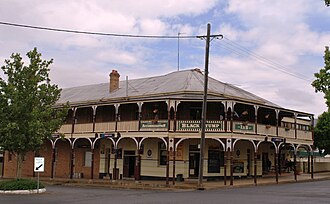ref=http://en.wikipedia.org/wiki/Black_Stump
....inspired by the term beyond the Black Stump I've created this cache..I found this Black Stump 'in the Outback of Nuriootpa as I was doing a Burke and Wills expediton in my hometown.
the following is an edited extracted from Wikipedia's page
Origin of the expression...........
The most prosaic explanation for the origin of ‘black stump’ derives from the general use of fire-blackened tree-stumps as markers when giving directions to travellers unfamiliar with the terrain. An early use of the phrase from the Sydney journal Bulletin (31 March 1900, p. 31) seems to lend support to this explanation: “A rigmarole of details concerning the turns and hollows, the big tree, the dog-leg fence, and the black stump”.
Robbery Under Arms, a fictionalised work by Rolf Boldrewood first published in 1888, refers to the Black Stump as an actual place "within a reasonable distance of Bathurst" and known to everybody for miles around. Boldrewood says it "had been a tremendous old Ironbark tree- nobody knew how old, but it had had its top blown off in a thunderstorm, and the carriers had lighted so many fires against the roots of it that it had been killed at last, and the sides were as black as a steamer's funnel."
Raffaello Carboni used the phrase 'black-stump' in his account of the Eureka Stockade uprising which he wrote in 1855, probably referring to a well-worn pipe: "Please, give me a dozen puffs at my black-stump, and then I will proceed to the next chapter".[3] There appears to be no obvious link between the use of the phrase by Carboni and the expression being used as an imaginary marker in the landscape.
Contested origin: places
The evolution of meaning of the phrase 'black stump', from the real to an imaginary marker of landscape, probably occurred during the nineteenth century. There is a widespread belief that the expression took root amongst carriers or teamsters that operated in the regional districts of Australia. Carriers were an integral part of the rural economy during the nineteenth century; they transported wool and supplies by drays drawn by horse- or bullock-teams, travelling constantly across the landscape servicing stations and settlements distant from regional transport hubs and urban centres.
If the use of the expression ‘black stump’ entered the Australian vernacular in the nineteenth century, it rarely appeared in Australian literature or newspaper reports until the twentieth century.
At least three towns in regional Australia claim to be home to the 'black stump': Coolah, NSW; Merriwagga and Gunbar in NSW; and Blackall in Queensland. Coolah, NSW

The Black Stump Hotel in Coolah
The area just north of present-day Coolah was known by local Aborigines as ‘Weetalibah-Wallangan’, apparently meaning “place where the fire went out and left a burnt stump”. In an attempt to control the settlement patterns of the colony of New South Wales Governor Darling issued regulations in 1829 limiting settlement in the colony to land within the Nineteen Counties surrounding Sydney. The regulations defined the “limits of location”, and it is claimed this boundary passed “along the approximate location of the Black Stump Run” (located just north-west of present-day Coolah). Land to the north of this part of Governor Darling’s boundary (it is asserted) began to be described as "beyond the Black Stump".
This raises the question: had the Black Stump Run been taken up by 1829 (or at least by the mid-1830s)? Darling’s “limits of location” was a short-lived concept; in 1836 Governor Bourke allowed individuals occupying lands beyond the Nineteen Counties to obtain annual licenses to legitimise their activities and the “limits of location” became officially irrelevant.
Apparently a teamster named John Higgins took up land in the vicinity of the Black Stump Run (possibly in the early 1860s when Robertson's Land Bills allowed land selection to occur). Higgins built an inn in the 1860s which he called The Black Stump Inn, located at the junction of roads leading to Gunnedah and Coonabarabran. The inn later became the Black Stump Wine Saloon and was destroyed by fire in 1908.[4] It has been suggested that the saloon was an important staging post for traffic to north-west New South Wales and it became a marker by which people gauged their journeys.[5]